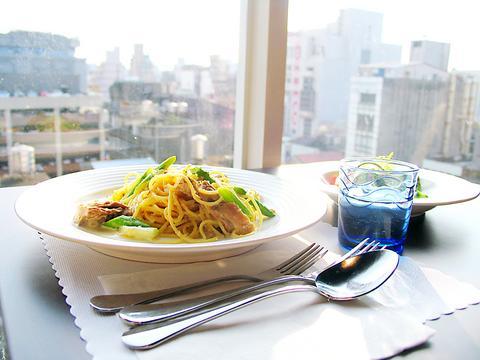Nestling near the top of the newly refurbished Eslite Wuchang Street Branch building in Ximending can be found the usual foodcourt suspects: a hotpot restaurant, a faux continental cuisine steak house, a Thai-style diner and the now ubiquitous Italian pasta joint.
Morita is no worse and no better than the rest. It has a range of set meals around the NT$300 mark and these are palatable, but you would not impress a date by going there. The surroundings are pleasant enough if you like pink lamps and wallpaper, which gives it a living room-type of ambiance. It has a great view of Ximending if rooftop apartments, water coolers, mired ceramic tile walls, streaked windows and corrugated iron roofs are your idea of an interesting panorama. The service was smart and friendly, without being anything to eulogize about.

PHOTO: JULES QUARTLY, TAIPEI TIMES
It could be said that spaghetti has in the last few years become the noodle of choice for many Taiwanese. Both noodles and pasta are made from wheat flour and salt is added, which is mixed with water to make a paste, dried and folded, then pulled and cut into long strips. Additions to the basic recipe include eggs for some noodles and pasta dishes, rice flour for rice noodles and vermicelli, fillings for gnocci and dumplings. Flavorings and colorings are as numerous as the spectrum of the rainbow.
Those who are familiar with the history of China will not be surprised to hear that it was the Chinese who originally invented pasta, possibly 5,000 years ago. Marco Polo, they say, introduced it to the Italians in the 13th century(along with ice cream and the pinata) who then conquered the culinary world with it.
It's recent popularity in Taiwan should come as no surprise then, where restaurateurs have quickly realized that a portion of pasta costs NT$10 a plate tops and the sauce isn't much more. Hence, repackage the noodles as pasta and increase the profit margins.
At these spaghetti restaurants you typically get a couple of microwaved buns that are sweet, white and cotton-like; followed by what is called a salad but is no more than a couple of leaves and shredded cabbage, set off by halved cherry tomatoes smothered in 1,000 island dressing. Often enough, it is all washed down with an iced tea. This is the pattern at Morita, with the addition of a dessert afterwards to give the impression of a more upmarket affair.
It may be cheap and cheerful but it's rarely enjoyable. I have sampled spaghetti in Italy and elsewhere around the world and the Taiwanese version does not come close, unfortunately. The pasta is rarely freshly made and often has that off the shelf and out-of-the-packet taste that coats the palate. The sauce, which as you would expect is the key, is invariably under par. It's tempting to stick with the noodles.

Exceptions to the rule are sometimes revealing. For a brief few years, there was an emerging ideological split between the Democratic Progressive Party (DPP) and Chinese Nationalist Party (KMT) that appeared to be pushing the DPP in a direction that would be considered more liberal, and the KMT more conservative. In the previous column, “The KMT-DPP’s bureaucrat-led developmental state” (Dec. 11, page 12), we examined how Taiwan’s democratic system developed, and how both the two main parties largely accepted a similar consensus on how Taiwan should be run domestically and did not split along the left-right lines more familiar in

As I finally slid into the warm embrace of the hot, clifftop pool, it was a serene moment of reflection. The sound of the river reflected off the cave walls, the white of our camping lights reflected off the dark, shimmering surface of the water, and I reflected on how fortunate I was to be here. After all, the beautiful walk through narrow canyons that had brought us here had been inaccessible for five years — and will be again soon. The day had started at the Huisun Forest Area (惠蓀林場), at the end of Nantou County Route 80, north and east

Specialty sandwiches loaded with the contents of an entire charcuterie board, overflowing with sauces, creams and all manner of creative add-ons, is perhaps one of the biggest global food trends of this year. From London to New York, lines form down the block for mortadella, burrata, pistachio and more stuffed between slices of fresh sourdough, rye or focaccia. To try the trend in Taipei, Munchies Mafia is for sure the spot — could this be the best sandwich in town? Carlos from Spain and Sergio from Mexico opened this spot just seven months ago. The two met working in the

This month the government ordered a one-year block of Xiaohongshu (小紅書) or Rednote, a Chinese social media platform with more than 3 million users in Taiwan. The government pointed to widespread fraud activity on the platform, along with cybersecurity failures. Officials said that they had reached out to the company and asked it to change. However, they received no response. The pro-China parties, the Chinese Nationalist Party (KMT) and Taiwan People’s Party (TPP), immediately swung into action, denouncing the ban as an attack on free speech. This “free speech” claim was then echoed by the People’s Republic of China (PRC),